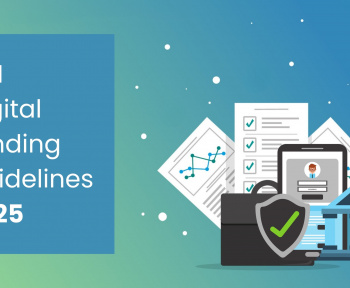The Indian digital retail lending market is anticipated to exceed $720 billion by 2030, constituting approximately 55% of the total digital lending market opportunity in the country, which is estimated to be over $1.3 trillion, according to the Q3 2023 report from Inc42 on the State of the Indian Fintech Ecosystem.
Driven by a strong compound annual growth rate (CAGR) of 22%, the market for digital consumer loans is expected to almost triple in size. This growth is attributed to favorable socio-economic factors and timely regulatory measures. The increased accessibility to credit is a result of the widespread use of digital lending apps, simplified KYC validation, and streamlined repayment options over the years, leading to a significant uptick in lending through digital channels.

Source: Inc 42
Prominent trends in retail lending in India
Rise of Digital Lending Platforms:
With the advent of digital technologies, a surge in digital lending platforms has revolutionized the retail lending landscape. Fintech companies are leveraging artificial intelligence (AI) and machine learning (ML) algorithms to assess creditworthiness quickly. These platforms have expanded financial inclusion by reaching underserved segments, offering instant loans, and providing seamless application processes.
Credit Scoring and Risk Assessment:
The use of alternative data for credit scoring is reshaping the way financial institutions evaluate borrowers. Traditional credit scoring models often face limitations, especially in assessing individuals without a credit history. Fintech lenders are employing innovative approaches, considering factors like social media behavior, utility payments, and even psychometric assessments to provide a more comprehensive view of an individual’s creditworthiness. Neo-banking platforms are disrupting the retail lending space by leveraging unconventional data sources to evaluate credit risk. These platforms provide individualized lending solutions to people who might have gone unnoticed by traditional banks by examining spending habits and financial behavior.
Personalized Loan Products and Microfinance:
The retail lending sector in India is witnessing a shift towards personalized loan products catering to diverse consumer needs. Microfinance institutions are playing a crucial role in empowering the unbanked population by providing small-ticket loans for entrepreneurial ventures, education, and healthcare. Small Finance Banks exemplify the impact of microfinance in the retail lending sector. By offering customized financial products and services to individuals in rural and semi-urban areas, they are fostering economic development and financial inclusion.
Digital disruption: Catalyst for change
The proliferation of digital technologies has ushered in a new era for retail lending in India. Fintech innovations, coupled with the government’s impetus for a digital economy, have expedited the loan approval process, making it more accessible for the average consumer. Mobile apps, online portals, and data analytics are not just buzzwords; they are transforming how lenders engage with borrowers. The ease of applying for loans, coupled with rapid disbursals, is reshaping customer expectations and pushing traditional financial institutions to reinvent their strategies.
Regulatory landscape: Navigating the compliance maze
The regulatory framework plays a pivotal role in shaping the contours of retail lending. The Reserve Bank of India (RBI) has been proactive in introducing measures to enhance transparency, protect consumers, and ensure the stability of the financial system. The RBI’s Regulatory Sandbox has provided a platform for fintech innovators to test and launch their products in a controlled environment. This initiative encourages experimentation while ensuring compliance with regulatory standards, fostering innovation in the retail lending sector.
Striking the right balance between promoting financial inclusion and mitigating risks poses a constant challenge. Understanding the implications of recent regulatory changes, such as altered risk weights on different loan categories, is crucial for both lenders and borrowers navigating the intricate web of compliance.
The credit conundrum: Balancing risk and inclusion
As lenders cast their nets wider to capture a diverse customer base, the challenge lies in effectively managing credit risk. Striking the delicate balance between inclusivity and risk mitigation is an ongoing juggling act. With the RBI’s recent focus on strengthening risk assessment mechanisms, lenders are compelled to reevaluate their credit scoring models. The quest for innovation in assessing creditworthiness, especially for the unbanked and underbanked segments, is opening avenues for alternative credit scoring methodologies and fostering financial inclusion.
Major catalysts in the retail and digital lending ecosystem
Retail lending in the nation is surging thanks to several digital models, including short-term credit availability, financing for small and medium-sized enterprises, and peer-to-peer (P2P) lending. Apart from this, the explosive growth of Buy Now, Pay Later (BNPL) applications is also worth mentioning. Both the launch of BNPL services by online retailers independently and through joint ventures with independent BNPL lenders have contributed to this growth. This multifaceted growth signifies a dynamic expansion of digital lending avenues, showcasing the adaptability and innovation within the financial technology sector.
According to the Reserve Bank of India (RBI) statistics, there was a 15% year-on-year growth in bank credit during the fiscal year concluding in March 2023. Bank advances surged from INR 118.91 lakh crore as of March 25, 2022, to INR 136.75 lakh crore as of March 24, 2023. These figures not only emphasize the substantial expansion within India’s banking sector but also underscore the vital role that banks play in driving significant credit growth and economic development. Various lending models are making this possible.
One major development in the retail lending industry in India has been the announcement of the Co-Lending Model by the Reserve Bank of India. Apart from enhancing access to credit for the economically weaker sections and MSMEs, the CLM contributes to addressing liquidity constraints and systemic risks for lenders.
Another key offering marking an unconventional shift from traditional banking is Embedded Finance. By leveraging digital channels, users can easily establish deposit accounts, apply for debit cards, access credit, and fulfill a substantial portion of their financial requirements. Notably, these platforms diverge from traditional brick-and-mortar banking institutions. Instead, they are innovative enterprises forming partnerships with banks and tech providers to integrate financial services seamlessly, creating a cohesive, user-centric, and uncomplicated customer journey. This groundbreaking collaborative approach involving banks, technology partners, and distributors of financial solutions through non-financial channels is the catalyst for what is widely recognized as the transformative progression of embedded finance. As per India Brand Equity Foundation, on a global scale, embedded financial services are projected to evolve into a substantial US$ 230 billion industry by 2025, experiencing a significant surge from the US$ 22.5 billion revenue recorded in 2020.
Catering to the tech-savvy, instant-gratification-oriented population of the country, Buy Now, Pay Later schemes have become very popular very quickly. The global e-commerce transaction value for Buy Now, Pay Later (BNPL) is anticipated to exhibit a Compound Annual Growth Rate (CAGR) of 16% from 2022 to 2026. BNPL provides a flexible and accessible alternative to traditional credit, enabling users to spread the cost of purchases over manageable installments without incurring interest charges when payments are made on time. Moreover, it caters to a diverse consumer base, including those with limited credit histories. By encouraging financial inclusivity and offering a seamless, interest-free financing option, BNPL not only stimulates economic growth but also aligns with evolving consumer preferences, making it a compelling choice for those seeking convenience and budget-friendly payment solutions.
The need for digital debt collections amidst a burgeoning retail lending ecosystem
As demographic shifts unfold and economic dynamics fluctuate, the expansion in retail lending underscores the crucial need for seamless, scalable, and tech-driven solutions in collections as well.
The advent of modern technology, incorporating Artificial Intelligence, Machine Learning, Data Analytics, Predictive Analysis, and Natural Language Processing (NLP), is gradually spearheading a digital transformation. In the realm of digital debt collections, these technologies are harnessed to create tailored segments based on borrowers’ demographic profiles, repayment behaviors, and response rates across various channels. This approach enhances the efficiency of lenders’ traditional strategies. The subsequent imperative steps involve identifying borrowers’ preferred communication channels and crafting personalized content to engage them, thereby increasing the likelihood of successful debt repayment.
The transition from traditional, manual collections to a technology-led, debtor-centric approach is indispensable for financial institutions aiming to fortify their resilience. Digital debt collections leverage artificial intelligence, machine learning, and data analytics to personalize engagement, improve resolution rates, and reduce operational costs. This synergistic relationship between retail lending and collections not only enhances the borrower experience but also fortifies the financial services industry against uncertainties, creating a foundation for sustainable growth and financial inclusion.
From a regulatory standpoint, digital debt collections will play a crucial role in ensuring compliance with evolving standards set by bodies like the Reserve Bank of India (RBI). As regulatory requirements become more complex, technology will be instrumental in automating and streamlining compliance processes, reducing the risk of errors, and ensuring adherence to protocols. This not only safeguards the interests of lenders but also enhances transparency and accountability in the debt recovery process.
Looking forward
The rapidly evolving retail lending landscape in India is a testament to the nation’s journey towards financial inclusion and innovation. As the sector experiences exponential growth, the fusion of fintech ingenuity, regulatory responsiveness, and shifting consumer expectations is paving the way for a dynamic and inclusive lending ecosystem. Moving forward, the relationship between technology, regulatory frameworks, and consumer demands will continue to shape the narrative, ensuring that retail lending in India remains a catalyst for accessible credit, responsible financial practices, and a vibrant financial future for all.
The symbiotic relationship between traditional financial institutions and agile fintech disruptors, guided by supervision from regulatory bodies, underscores a collaborative approach to financial evolution. As India’s journey towards greater digital adoption unfolds, it promises not just financial convenience but a fundamental shift towards a more inclusive, efficient, and technologically enriched financial services industry.
If you are looking to transform your debt collections strategy with the power of digital and data powered insights, reach out to us to request an exploratory session at sales@credgenics.com or visit us at www.credgenics.com.




